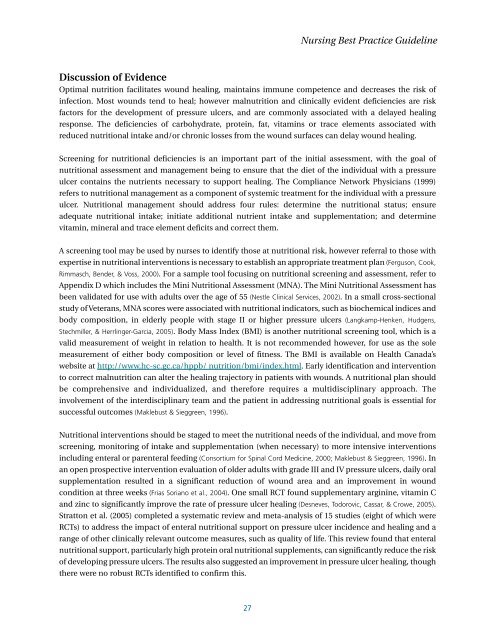RNAO BPG Pressure Ulcers Stage I to IV - Faculty of Health ...
RNAO BPG Pressure Ulcers Stage I to IV - Faculty of Health ...
RNAO BPG Pressure Ulcers Stage I to IV - Faculty of Health ...
You also want an ePaper? Increase the reach of your titles
YUMPU automatically turns print PDFs into web optimized ePapers that Google loves.
Nursing Best Practice GuidelineDiscussion <strong>of</strong> EvidenceOptimal nutrition facilitates wound healing, maintains immune competence and decreases the risk <strong>of</strong>infection. Most wounds tend <strong>to</strong> heal; however malnutrition and clinically evident deficiencies are riskfac<strong>to</strong>rs for the development <strong>of</strong> pressure ulcers, and are commonly associated with a delayed healingresponse. The deficiencies <strong>of</strong> carbohydrate, protein, fat, vitamins or trace elements associated withreduced nutritional intake and/or chronic losses from the wound surfaces can delay wound healing.Screening for nutritional deficiencies is an important part <strong>of</strong> the initial assessment, with the goal <strong>of</strong>nutritional assessment and management being <strong>to</strong> ensure that the diet <strong>of</strong> the individual with a pressureulcer contains the nutrients necessary <strong>to</strong> support healing. The Compliance Network Physicians (1999)refers <strong>to</strong> nutritional management as a component <strong>of</strong> systemic treatment for the individual with a pressureulcer. Nutritional management should address four rules: determine the nutritional status; ensureadequate nutritional intake; initiate additional nutrient intake and supplementation; and determinevitamin, mineral and trace element deficits and correct them.A screening <strong>to</strong>ol may be used by nurses <strong>to</strong> identify those at nutritional risk, however referral <strong>to</strong> those withexpertise in nutritional interventions is necessary <strong>to</strong> establish an appropriate treatment plan (Ferguson, Cook,Rimmasch, Bender, & Voss, 2000). For a sample <strong>to</strong>ol focusing on nutritional screening and assessment, refer <strong>to</strong>Appendix D which includes the Mini Nutritional Assessment (MNA). The Mini Nutritional Assessment hasbeen validated for use with adults over the age <strong>of</strong> 55 (Nestle Clinical Services, 2002). In a small cross-sectionalstudy <strong>of</strong> Veterans, MNA scores were associated with nutritional indica<strong>to</strong>rs, such as biochemical indices andbody composition, in elderly people with stage II or higher pressure ulcers (Langkamp-Henken, Hudgens,Stechmiller, & Herrlinger-Garcia, 2005). Body Mass Index (BMI) is another nutritional screening <strong>to</strong>ol, which is avalid measurement <strong>of</strong> weight in relation <strong>to</strong> health. It is not recommended however, for use as the solemeasurement <strong>of</strong> either body composition or level <strong>of</strong> fitness. The BMI is available on <strong>Health</strong> Canada’swebsite at http://www.hc-sc.gc.ca/hppb/ nutrition/bmi/index.html. Early identification and intervention<strong>to</strong> correct malnutrition can alter the healing trajec<strong>to</strong>ry in patients with wounds. A nutritional plan shouldbe comprehensive and individualized, and therefore requires a multidisciplinary approach. Theinvolvement <strong>of</strong> the interdisciplinary team and the patient in addressing nutritional goals is essential forsuccessful outcomes (Maklebust & Sieggreen, 1996).Nutritional interventions should be staged <strong>to</strong> meet the nutritional needs <strong>of</strong> the individual, and move fromscreening, moni<strong>to</strong>ring <strong>of</strong> intake and supplementation (when necessary) <strong>to</strong> more intensive interventionsincluding enteral or parenteral feeding (Consortium for Spinal Cord Medicine, 2000; Maklebust & Sieggreen, 1996). Inan open prospective intervention evaluation <strong>of</strong> older adults with grade III and <strong>IV</strong> pressure ulcers, daily oralsupplementation resulted in a significant reduction <strong>of</strong> wound area and an improvement in woundcondition at three weeks (Frias Soriano et al., 2004). One small RCT found supplementary arginine, vitamin Cand zinc <strong>to</strong> significantly improve the rate <strong>of</strong> pressure ulcer healing (Desneves, Todorovic, Cassar, & Crowe, 2005).Strat<strong>to</strong>n et al. (2005) completed a systematic review and meta-analysis <strong>of</strong> 15 studies (eight <strong>of</strong> which wereRCTs) <strong>to</strong> address the impact <strong>of</strong> enteral nutritional support on pressure ulcer incidence and healing and arange <strong>of</strong> other clinically relevant outcome measures, such as quality <strong>of</strong> life. This review found that enteralnutritional support, particularly high protein oral nutritional supplements, can significantly reduce the risk<strong>of</strong> developing pressure ulcers. The results also suggested an improvement in pressure ulcer healing, thoughthere were no robust RCTs identified <strong>to</strong> confirm this.27
















